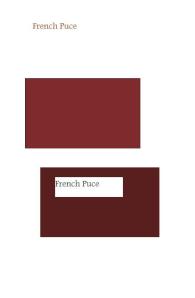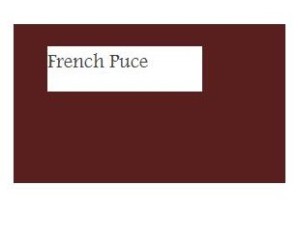Blair, the catalog company for 40 plus (or maybe 50 plus) women is selling puce. They have puce pink nailed with “orchid haze” and “dusty berry.” They have a light puce purple, “dusty plum”, medium puce purple, “concord grape,” darker puce purple, “eggplant” and “plum wine”. French puce appears as “cinnamon” and dark puce red shows up as “brick”. “Mystic mauve,” “deep berry” and “winterberry” come close but are not quite muted enough for puce.
They’re Selling Puce
Some online retailers are rockin’ the puce this year but of course, they don’t call it that. At least…the American ones don’t.
I just bought a longsleeve tee from Eddie Bauer that is a perfect shade of puce purple…a deep, but not too dark, purple with just a hint of red, muted with grey and heathered. EB calls it “Regency Purple,” which is perfect, as this color was popular during the Regency period in England.
Lands End is selling any number of puce shades. One of the most spot-on is their puce pink, the color that most people think of as puce these days if they’re smart enough to know that puce isn’t green. (I like to call puce pink “greyish magenta” — if it isn’t muted, I don’t consider it puce, although some do.) Lands End calls their puce pink “French Orchid.” Both French and English fashion plates from the late 1700s feature puce pink, though these plates just call it “puce” and do not attempt to distinguish it, name-wise, from the darker shades.
Lands End also has a shade very close to puce purple called “rich eggplant” , and a dark puce red they call shiraz in their sweaters and rose red in their outerwear.
They’re selling puce brown stretch pants called “raisin” and a French puce brown dress called “cinnamon bark.”
Land’s End’s raspberry plum is so close to puce I want to call it that, but it’s not muted with grey or brown so I can’t sanction it.
Lands End Canvas has a French puce sweater in a shade they call Burnt Cinnamon — it’s halfway between brown and red-orange.
LL Bean Signature is selling a poplin dress in an unusual puce red they call “Black Cherry.”
Posted in Uncategorized
“True” Puce?
Puce is many colors and no color. It’s defined in so many ways as almost to defy all meaning. The only thing everyone agrees on is that it’s not a primary color and it’s not on the yellow spectrum. But I am devoted to puce because there are shades called puce that are breathtakingly beautiful and so unique that there is no other word to describe them.
Francophiles probably already know that puce is French for “flea”. This is our first and most important clue as to what puce might truly be. Fleas’ bodies, magnified, range from dark brown along their backs to bright orangey-red-brown along the belly area. It is fun to note that in French, the world “puce” is used in many contexts. It’s an insect, it’s a color, it’s your sweetheart, it’s something tiny such as a small pearl, it’s an electronic part. In researching puce clothing on French sites I had to search for “couleur puce” (“puce color”). When I entered “robe puce” (“puce dress”) I ended up with a myriad of pictures of people’s babies (“ma puce”, translated roughly as “my sweetie”) wearing dresses in every possible shade, and I discovered a brand called “Marie Puce”, a French maker of children’s clothing. It was rather stunning to learn of ladies calling their babies, in essence, “my flea”.
And now, a history break. While Wiki sites inform us that the use of the term “puce” as a color dates back to 14th century France, Marie Antoinette supposedly popularized it in 1775 when her royal husband described her new dress as “flea-colored.” (Husbands, can’t live with ’em, etc. etc.) Since weird nature-names for colors were popular in her circles… a fashionable color was “crown prince poop”… the Queen of Fashion seized on the idea and as a result different shades of the color, named for parts and life cycles of the flea, were created. Despite hours and hours of searches over these past several moons, I still don’t know what color Marie Antoinette’s courtiers and ladies were wearing when they sported “flea’s back” (“dos de puce”) or “flea’s belly” (“ventre de puce”) though my guess is that “flea’s back” was a dark shade and “flea’s belly” a brighter one.
But rocketing back to present day, you will find the following definitions of puce:
1. A shade of green. Source: chatting individuals and a few catalog companies. Let’s settle this point right now. It’s not. Chartreuse is a shade of green. Fleas are not green. Case closed. I have spoken.
2. A shade of purple. This is the most common English language definition you’ll find. Those who embrace the purple definition describe it as brownish-purple (the most common), dark purple or dark greyish-purple. My Halloween costume, shown in my November 2012 entry, falls into this category. (But I was wrong when I said it’s the Marie Antoinette definition.) Here is Lena Dunham wearing this color, described as “eggplant” by the commentators:
3. A shade of red. Those who espouse the concept of puce as a red shade describe it as dark red or violet-red. From the discussions I’ve read, this concept seems to arise from the idea of puce not being the color of a flea, but rather of the blood-color poop stains they leave on sheets. Call it “sang de puce”?
4. A shade of pink. This is the philosophy embraced by the puce fans who have a kind of running joke about reviving puce’s popularity. There are buttons and bumper stickers in greyish lavender-pink that say “Puce: It’s a Color”, “Give Puce a Chance” (I have the button) and “Got Puce?”. When you google puce photos, greyish-lavender-pink frequently comes up. Some computer programs define puce in this tone. (The Title and Subtitle of this blog consist of this shade. Yes, I picked the color.)
4. A Shade of Brown. If you want to be a purist and stick with the definition provided by the country that started the madness, this would be the way to go. The French color website pourpre.com defines it as “dark reddish brown,” declares it to be in the brown category, and places it in the orange-red-brown spectrum, not a spec of blue to be seen and thus flat-out contradicting the common English-language definition of “brownish purple.” Below is my attempt to depict this color.
French dictionaries describe it the same way; one French site called it a reddish “marron,” marron meaning brown with a hint of red in it. In other words, puce is a redder reddish brown. A French wiki site that shows many shades of brown present both puce and marron, and the two are almost indistinguishable. (Maroon, in English, is a dark brownish-red, rather than a red-tinged brown.)
There is a lovely French language website, Le Etoiles de ArtLubie, that depicts paintings of ladies in gowns, and two of them date back to the first half of the 19th century, during a period when puce was popular. The site describes the dresses worn in two of the pictures as “puce” — they are of an intense orange-brown, very similar to ginger, and nothing remotely akin to the greyish pink-violets and lavender-browns shown on English language sites.
Pantone, the English language color experts who dictate on-trend clothing and decorator colors to much of the fashion world, sends samples of their colors to your home for a nominal price. My color sample of “puce” is a deep brown tinged with red-purple. So it’s almost like the French shade of dark puce, but less orangey.
5. And finally…Orange and blue mixed together. As the right combination of orange and blue would create a lavendar-brown shade, this makes sense, but the problem is that the wrong shade of orange will make the color come out a sickly green. Hmmm…perhaps that’s the reason for the Puce Green myth.
So What’s the Takeaway? My mother always taught me to keep up with the times and since most modern sites see puce as one or another shade of violet often mixed with pink or red and usually mixed with grey or brown, I’m going with that view of puce, and embracing the use of the word where the shade is so unusual, there’s no other word for it. Greyish magenta and brownish grape-purple don’t have their own color names so the word “puce” fills a need in those instances. Dark reddish brown already has an English color name, mahogany. Flea’s belly is ginger or sienna. So while I respect the French definition as appropriate to their language needs, I think that for English speakers, the purply puce works best.
A Puce Excuse
Here is my contribution to the blogosphere’s Great Puce Debate. I’m going with Marie Antoinette’s contemporaries and defining puce as purplish-brown. This Halloween dress is dark puce, the color of a flea’s back (“dos de puce”):
Posted in Uncategorized
Exercise and Sports: At your own pace.
I wasn’t an athletic child, which made it difficult for me to learn the sports and games we played in P.E. We all know the stigma attached to kids who aren’t strong or athletic, and this stigma ends up shaming kids and discouraging them from being active.
Even today, as I’m trying to exercise more, I get looks from people when they ask me how much weight I can “bench press” (I don’t actually use a bench press but I use other weight-machine features) because the answer is a low figure. On the arm pulley weight feature I use, I can do 30-40 at 20 pounds. I can do five to ten repetitions at 30 pounds. There’s a couple of other features where I can’t go over 10 pounds. I’m not a physical powerhouse, and I have a problematic back, so I have to be extremely careful. However, the repetitions at 20 pounds are making me much stronger.
Some people can walk three miles at 5 miles per hour. I can walk about 3/4 mile at 3.5 miles per hour. More than that and my feet hurt and I become winded. But I worked up to that from about 1/3 of a mile, and I hope to get up to a mile at 4 mph soon. For me, that’s an intense, brisk walk. And I’m getting stronger and more fit all the time.
We’re told we’re supposed to exercise briskly for an hour a day. Right now, I’m not in a physical position to do that. Maybe one day I will be; maybe not. I’m not going to push myself to do an hour a day because of some one-size-fits-all standard. I’m going to do what I feel comfortable with, and then push myself to do a little more.
A couple of summers ago, when I first started swimming regularly, I struggled at first to swim half a short lap. By the end of that summer I could swim the length of an Olympic sized pool and back. I built up to that gradually, at my own pace. When I achieved it, I felt like a Titan.
If this country is to overcome obesity and get more physically fit, we need to get over judging people for how much they can do, and instead focus on whether people are doing what they can. Most of us aren’t professional athletes so it won’t add a day to our lives if we can bench press 100 pounds instead of 30 pounds. The road to fitness shouldn’t be a competition, it should be a pleasurable challenge for every one of us, and we should all cheer each other on.




